The Marketing Guy Tackles a ‘Data Recovery’ Case
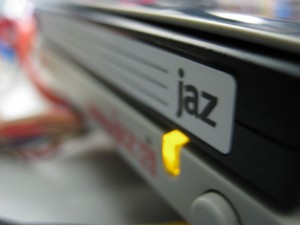
We get calls about getting data off of obsolete media – old laserdiscs, Zip discs, floppies, you name it. Someone has important data on a format they can no longer read.
It’s not really “data recovery” as we interpret the phrase – there is nothing to repair inside a clean room, no complex logical problems to solve, nothing that requires reverse engineering or custom software development. In short, there is nothing that would require Gillware. The problem is usually just finding a working reader that will cooperate with both the old discs and a new computer. It’s more of a shopping expedition, followed by some interface problems and tedium.
Hiring us to do it is a bit like having a dentist brush your teeth, or having Gordon Ramsey make you a sandwich.
The person on the phone today with the obsolete media was a scientist at a large research university.
“There’s just a bunch of Iomega Jaz discs, 1 and 2 gigabytes, and some other discs as well,” she said. “We have some old Jaz readers, but my IT guy here doesn’t think they work reliably anymore. There’s a bunch of research on it that I’d just like to put on a thumb drive or something we can use.”
I asked the nearest Gillware engineer what he thought of the case.
“Tell her to go on eBay and buy a Jaz reader for $30. If she doesn’t want to do that, it’ll be expensive. We’ll have to put someone on it, like one of us, and that’ll be data recovery rates. So five hundred or so, assuming we can get everything she wants. But just tell her to go on eBay and make a day’s project out of it.”
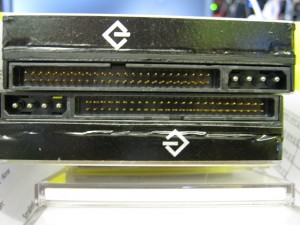
“That’s fine,” she said. “We don’t even have a computer that works with those readers – no scuzzy interface.”
When dealing with real challenges, sometimes it’s nice when the hassles can be sent to someone else.
I told the engineer.
“It’s your case,” he said.
I clicked “Buy it Now” and began my first journey into data recovery. Or data retrieval case. Whatever you want to call it. Data hassle case.
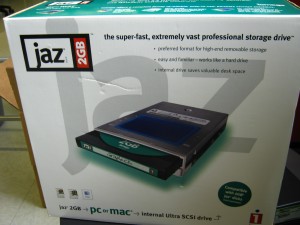
The discs arrived in a large box, almost 30 of them in all, plus four or five readers that looked pretty old and sad. In contrast, the Iomega Jaz reader from eBay truly was New Old Stock (NOS) and still had the shine on its box corners. It screamed out from the past with the promise of high capacity! It was a big pile of once state-of-the-art backup equipment, high-end stuff complete with Ultra SCSI connections and capacities bragging about 2GB! Upon seeing it I burst into song: “In the Year 2000.”
We were instantly fond of/annoyed with the fickle Iomega Jaz discs, which started to be called “Yahz” drives, or “Yahts,” if you really wanted to go full German on them.
For people interested in hard drives, they are a nifty technology. They break so many rules of what a hard drive is supposed to be. An Iomega Jaz system is essentially a hard drive that comes apart in two pieces – the platter assembly is one piece; the drive is the other. The drive itself is the motor, control board, motor, and read/write head assembly. It’s what bolts into a desktop computer. The removable disc or cartridge holds two silvery round platters inside its square-ish plastic shell.
What is kind of mind warping about this setup is that we would not remove the platters from a hard drive unless it was in a clean room. It’s a kind of gospel that hard drive platters have to be protected at all times from any possible contaminant. But your everyday Jaz drive user is yanking the platters out of their read/write head assembly willy-nilly. The only thing that protects the platters from the open air is a plastic shell with a thin ribbon of retractable metal on one end. The drive has a little plastic flap held down with a tiny spring – that’s all that separates its read/write heads from the outside world. You can push it up with your finger, like the flap of an old cassette player. When you peer inside, you see the read/write heads! Just back there in the open!
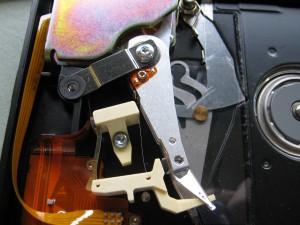
The read/write heads of a contemporary hard drive have loop sizes that are invisible to the naked eye. They fly at a height above the platters at a distance measured in nanometers. You could count the number of air molecules that fit in that gap. The drive has calibration information unique to each platter; that’s how dialed in a contemporary hard drive has to be.
But where a contemporary hard drive may hold 3,000 GB of data, the Jaz disc holds 1 or 2 GB. Its read write heads are clearly visible by the naked eye; with skill, you might even be able to thread something through one. Still, the Jahts drive has its charms. In a white paper, we once referred to a device that you could insert various hard disc platters into and have them be read as the “Holy Grail of data recovery.”
The Jaz drive is not that! It only accepts its own 1 or 2 GB drive. But even though it’s no Holy Grail, swapping hard drive platters in and out of a device that reads them feels a little bit Knights of the Round Table. The Jaz drive represents a unique solution to data storage, but device not detected issues are still within the realm of possibility.
A decade ago, drives with similar qualities to the Iomega Jaz drive were tolerant of many techniques of data recovery. You could swap control boards, for instance, and have a shot at success. There wasn’t calibration information unique to the platters that existed on a control board chip. These were the kinds of drives that gave birth to data recovery tips that are now destructive: the freezer, the hammer and the oven treatments.
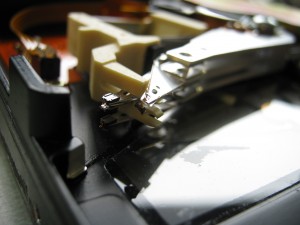
Although this bulkier, larger, lower capacity technology was tolerant to some DIY data recovery efforts, the Jaz drive seems pretty vulnerable during normal use. The act of essentially jamming platters in and out of an open hard drive creates problems, and the Jaz system has limited ability to keep out contaminants over time. When we were testing the University’s supplied Jaz drive, we found one simply had a mangled read/write head. The internet suggests that this was common when you forced a disc to eject. The edge of the platter simply caught the read/write head assembly and bent it.
The danger is that a damaged Jaz drive would scratch the discs inserted into it. Data is held on an ultra-thin mirror-like magnetic coating on these platters, just as on a hard drive. It can be scratched off if something contacts the spinning discs. Of course, this rotational scoring happens with hard drives, too.
So we were careful to test all the supplied Jaz drives and we ruled them all out. We trusted only the NOS Jaz drive, and retested its performance before imaging all the Jaz discs.
This was pretty tedious, and the $500 started to look like a better and better deal for our client.
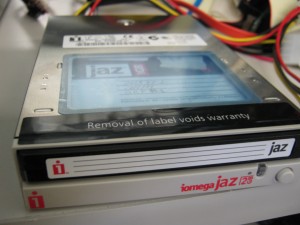
As the work went on, I fell into the main trap of someone new to data recovery: My spirits soared when I could see the data being read; they plunged when I saw read errors. I was completely emotionally invested in the end results.
The reason I think that this company was founded and that people are drawn to this field comes down to this: the work is worthwhile. The job is to help someone who has lost something find it again. Success is reaching into the abyss to reunite someone with something dear to them. Maybe it’s their photos, their unfinished novel, their grad school research that now holds a key to fresh discovery. It could be the records that keep the business that they’ve poured their lives into alive.
Anyway, anyone knows what it’s like to lose — to search for what seems lost. To be the one to find what’s lost and bring it back is a pure joy. When data recovery succeeds, we get to do that. And I wanted it bad.
This is one of the things I was warned about by a founder of Gillware, who is married to a physician. The idea is something like: first do no harm, make the best effort, and accept the results. Not every case can be solved, but every case demands the best care. To keep giving every case your best effort, you cannot afford to be crushed by failure; the others ahead that will need you whole.
Still, I found myself investing everything I had on the outcome of this one: Because this was not a real data recovery case! It was a data hassle case! I was emotionally all in on its success!
And how sweet it was when I successfully imaged all those discs and asked a recovery engineer to extract the data from those images! What was lost was found! O, Fortune, ever waxing!
This is why we recommend just going to eBay and solving your old media issues. The thrill can be yours!
But we’re always here for you if you’d rather the hassle be ours.
